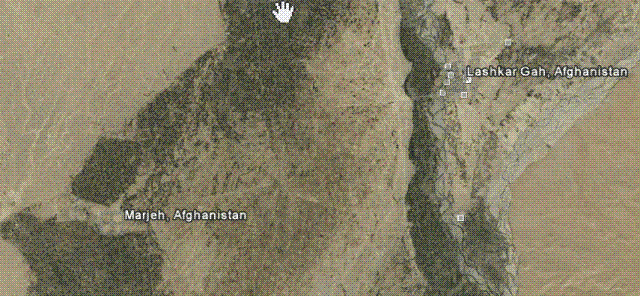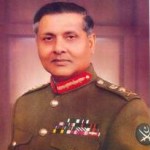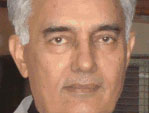By General Mirza Aslam Beg
A “massive build-up” is afoot for the battle of Marjeh, which is the strong-hold of Taliban in the Helmand province of Afghanistan. About fifteen thousand ground troops, reinforced by twenty thousand Afghan Army and police force will launch the offensive, supported by the entire US-NATO air power in Afghanistan. The objective is “to inflict a crushing defeat” on the Taliban, at Marjeh, which is considered “a bastion of Taliban power,” and set the momentum for their defeat in other areas, thus restoring government control over the territories of Afghanistan. Indeed, it is a very ambitious plan against the Taliban, who control thirty provinces, out of thirty four and rule the country-side. The surge of 30,000 American troops to be completed by August this year is expected to accomplish the task of restoring government control over Afghanistan.
 Marjeh which lies about 15 KM west of Lashkargah – the provincial capital of Helmand is a plain sandy area with scattered mud huts, and a green belt to the south and the west, fed by the Helmand River. The green belt is sparsely populated with about 6-7000 people. The area is open, not at all suited for positional defence, nor for hit and run operations of the Taliban. In the vast open areas, the coalition air power and the mobile armoured troops would be able to drastically limit Taliban movement and their operational effectiveness. What kind of resistance, therefore the coalition forces are expecting for which the “massive build-up”, is taking place?
Marjeh which lies about 15 KM west of Lashkargah – the provincial capital of Helmand is a plain sandy area with scattered mud huts, and a green belt to the south and the west, fed by the Helmand River. The green belt is sparsely populated with about 6-7000 people. The area is open, not at all suited for positional defence, nor for hit and run operations of the Taliban. In the vast open areas, the coalition air power and the mobile armoured troops would be able to drastically limit Taliban movement and their operational effectiveness. What kind of resistance, therefore the coalition forces are expecting for which the “massive build-up”, is taking place?
Taliban are well-versed in this game of fighting in the desert regions of South and the rugged mountains, for the last thirty years. They are the die-hard freedom fighters, motivated, self-assured and confident of victory against the occupation forces. Time is on their side. Their strategy for the battle of Marjeh therefore can be easily envisaged: They would rather hold Marjeh lightly, with a maximum of 2-3000 die-hard fighters, who would fight to the last man, killing as many of coalition forces, as possible. The use of strong and dispersed defenses, reinforced by IEDs ‘Omar Bombs’ and booby traps, would cause attrition on the attacking troops. Under-ground defensive net-work, on the pattern of Hezbollah’s defenses against Israelis in the 2006 war, would add to the strength of the resistance.
The bulk of the Taliban fighting force in Helmand area is estimated at 10-12000, which is likely to operate around the combat zone of Marjeh, to carryout interdiction of supply lines, logistics, support bases and may engage the coalition forces from several directions. While the battle of Marjeh rages, which will be long and bloody, the Taliban operating in other provinces, under their control will intensify their activities against the occupation forces, causing dispersion and greater attrition. The story of total defeat of the British Army of 1898, will not be repeated because, the air power of the coalition forces will save the day. A stalemate will occur.
The result of this battle as well as the war in Afghanistan is the real contest between two opposing will. The coalition forces are demoralized and defeated, fighting a war which has no ideal and no moral justification. Whereas the Taliban are fighting for the freedom of their homeland, with faith in themselves and belief in the Divine Intervention, which has helped them defeat the mightiest of the mighty, during the last thirty years. In fact, the Asymmetric Warfare, waged by the Shadow Army of Taliban has determined the contours of the emerging global order, by putting limits to the expanding menace of global hegemony, primacy and pre-eminence. Maulana Jalaluddin Roomi’s prediction indeed has come true: “The Giants come forward from Afghanistan and influence the world.”
In May 2003, when Afghanistan was occupied by the coalition forces, Jalaluddin Haqqani declared: “We have decided to fight, till we are free. We will never submit to the demands of the occupation forces, because our national ethos and traditions do not allow that. Freedom is our goal and our destiny. Win we will, Insha Allah.” A common friend, who has just returned from Afghanistan, told me: “I found them, so much at ease with themselves. So cool, calm, perceptive and committed to their cause and total surrender to the will of Allah – They say the time is on their side, whereas, it is running-out for the oppressors in Afghanistan.”
It is obvious that the outcome of the battle of Marjeh would be a stalemate and the heavy casualties, the coalition forces are likely to suffer. In no way it would help the peace process in Afghanistan. Sagacity demands that the USA and their coalition partners show greater sincerity of purpose for peace and give up the idea of use of force for gains, at this belated stage, when the Taliban enjoy clear ascendancy over the occupation forces, and with each passing day, more and more tribals are joining them. Attempts are being made to separate the Al-Qaeda from the Taliban who would not abandon them. If they could, they would have handed-over Osama to the Americans nine years back and saved themselves from the ravages of war. There are no good and bad Taliban either. They are all the same, and follow Mullah Omar. No amount of money can buy-them-of either, because they are not a saleable commodity. Let us therefore accept the reality and initiate the peace process in real unrest.
Special modalities, therefore, are needed for bringing peace in Afghanistan and to ensure an honourable way out, for USA and its allies, and a smooth transition to the civil order, “without triggering bigger chaotic conditions.” There are “terrifying prospects of defeat in Afghanistan” hence the need for “a comprehensive strategy and an exit strategy,” which is the only viable option, to be supported by an aggressive political and diplomatic policy for peace in Afghanistan. The steps, therefore, that needs to be taken are:
The occupation forces must give “a time-frame for withdrawal and declare a cease-fire.” Start dialogue with the Taliban and Northern Alliance, to form the Loe Jirga, to decide the main issues, such as the formation of the Interim government, for a period of three years, which will be responsible for holding the Census to determine who is who, for the impending elections; framing of a new Constitution; rebuilding of Institutions; massive reconstruction of the infrastructure and re-creating ethnic balance, which remains disturbed since the Bonn Conference of 2001 and holding of general elections in the year 2013 and finally transfer power to the elected government.
The centres of power – Pakistan and the Afghan Taliban – must be taken into cognizance, as the main arbiters of peace and the immediate neighbours – Iran and China must also be on board.
_________________________________________________________________________
General Mirza Aslam Beg is the former Chief of Army Staff, Pakistan Army. He is also the Founder Chairman of  FRIENDS, a Think Tank based at Rawalpindi. He contributes his articles regularly to Opinion Maker.
FRIENDS, a Think Tank based at Rawalpindi. He contributes his articles regularly to Opinion Maker.

After graduating from college, I joined Pakistan Army and was commissioned in a Tank Regiment. I am a veteran of the Indo-Pakistan war. After leaving the Army, I joined IT as a profession. I was hired by Kuwait Air Force And Air Defence as an Adviser to computerize its entire operation. Here I was the Chief Coordinator of the Project, Kuwait Automated Support System (KASS). It was a state-of-the-art leading-edge technology where we established over 500 online terminals network with dedicated voice and data communications. It had Satellite linkups to connect with other systems and track the inventory movement for KAF & AD. On this project, I was coordinating with the US Navy, IBM World, AT&T, and Martin Marietta for the development, deployment, and operation of the KASS. Writing has always been a passion for me, been writing for 25 years for various newspapers and periodicals. Now for the last four years, I have formed my virtual Think Tank, Opinion Maker. Here we have some renowned writers from Pakistan and abroad who contribute regularly that’s helping the world opinion in some way. I am a keen golfer may not be a good one but play on a daily basis. I am also fond of using the camera to picture nature and people.
ATTENTION READERS
We See The World From All Sides and Want YOU To Be Fully InformedIn fact, intentional disinformation is a disgraceful scourge in media today. So to assuage any possible errant incorrect information posted herein, we strongly encourage you to seek corroboration from other non-VT sources before forming an educated opinion.
About VT - Policies & Disclosures - Comment Policy



